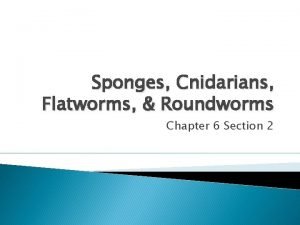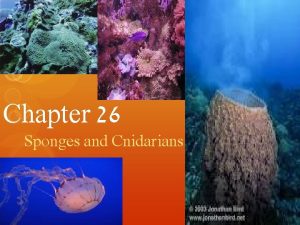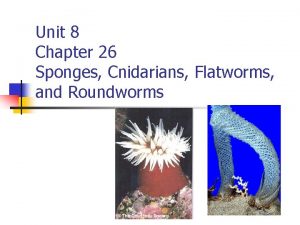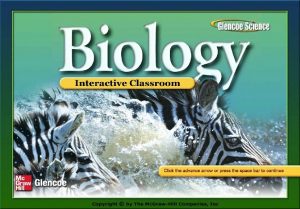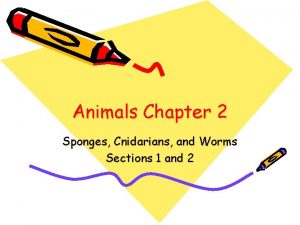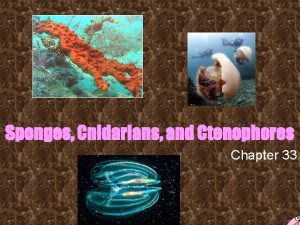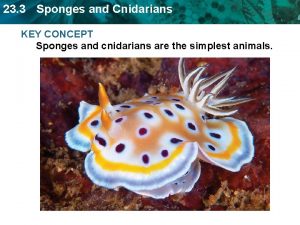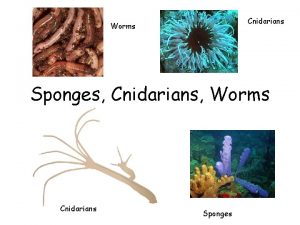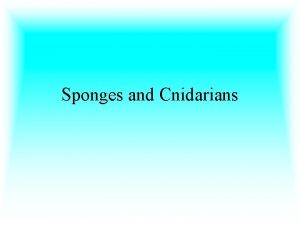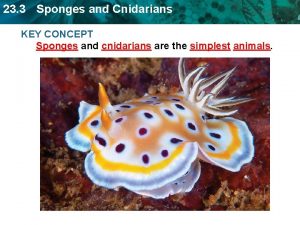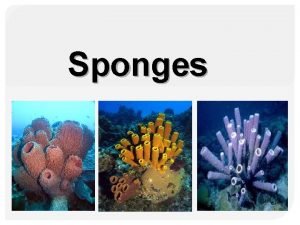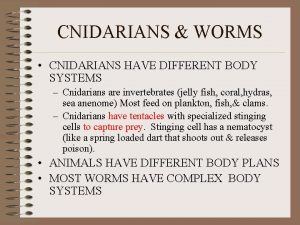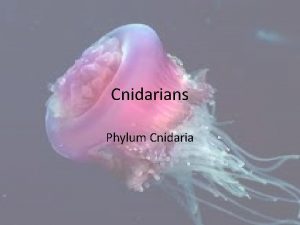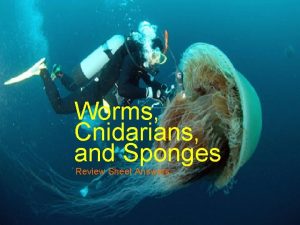23 3 Sponges and Cnidarians KEY CONCEPT Sponges









- Slides: 9

23. 3 Sponges and Cnidarians KEY CONCEPT Sponges and cnidarians are the simplest animals.

23. 3 Sponges and Cnidarians Sponges have specialized cells but no tissues. • Sponges are the most primitive animals on Earth. – 570 million-year-old fossils – closely related to group of protists • Sponges share common characteristics. – sessile – reproduce both sexually and asexually – filter feeders

23. 3 Sponges and Cnidarians • Sponges have several types of specialized cells. – pinacocytes – choanocytes spicule – amoebocytes osculum pore pinacocyte amoebocyte choanocyte

23. 3 Sponges and Cnidarians are the oldest existing animals that have specialized tissues. • Cnidarians have two body forms. – polyps In the polyp form of a coral, the tentacles and mouth face upward.

23. 3 Sponges and Cnidarians – medusas In the medusa form of a jellyfish, the tentacles and mouth face downward.

23. 3 Sponges and Cnidarians • Cnidarians are made up of two tissue layers separated by mesoglea. • The outer tissue layer has three cell types. – contracting cells – nerve cells – cnidocytes (which contain nematocysts) discharged nematocyst barbs coiled nematocyst gastrovascular cavity mouth mesoglea tentacle oral arms

23. 3 Sponges and Cnidarians • The four major cnidarian classes are defined by their dominant body form. – Anthozoans such as sea anemones have a dominant polyp stage.

23. 3 Sponges and Cnidarians • The four major cnidarian classes are defined by their dominant body form. – Hydrozoans such as hydra alternate between forms.

23. 3 Sponges and Cnidarians • The four major cnidarian classes are defined by their dominant body form. – Scyphozoans are jellyfish with a dominant medusa form. – Anthozoans such as sea anemones have a dominant polyp stage. – Hydrozoans such as hydra alternate between forms. – Scyphozoans are jellyfish with a dominant medusa form. – Cubozoans such as sea wasps have a dominant medusa form.
 Chapter 26 sponges and cnidarians answer key
Chapter 26 sponges and cnidarians answer key Chapter 26 sponges and cnidarians answer key
Chapter 26 sponges and cnidarians answer key Chapter 26 sponges and cnidarians answer key
Chapter 26 sponges and cnidarians answer key Chapter 24 introduction to animals worksheet answers
Chapter 24 introduction to animals worksheet answers Sponges cnidarians and worms
Sponges cnidarians and worms Section 33-1 review porifera answer key
Section 33-1 review porifera answer key Section 33-1 review porifera answer key
Section 33-1 review porifera answer key 2 body forms of cnidarians
2 body forms of cnidarians Minerals concept map
Minerals concept map Lesson 1 waves answer key
Lesson 1 waves answer key
